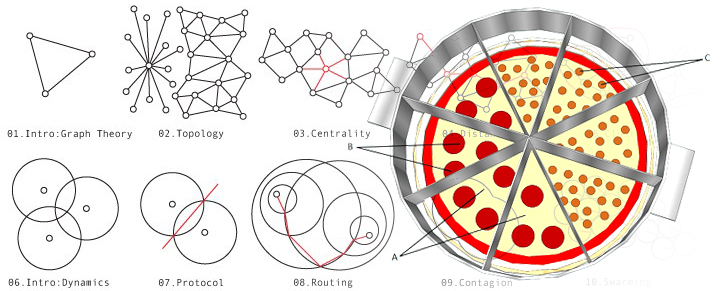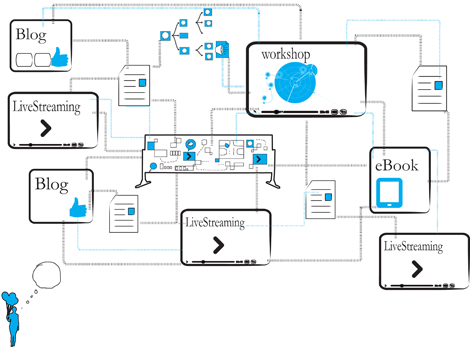
images above based on flickr pictures by Amber Case and Smite Me
–
I am very happy to share with you a post originally written for dreamhamar blog by our blogger and community manager Marisa, with whom I am collaborating in Ecosistema Urbano.
As one of my principal role within dreamhamar process is to develop theory and methodology for this architectural participation project, a few month ago I wrote What is Network Design Methodology? (originally in Spanish and translated in English by Marisa, thanks!) where I explained which methodology we were going to use for dreamhamar.
When Marisa was working to the English version of the article, she started detesting me :)
In the following text she explains why and she “translates” my words into an understandable language also for a non-architect. I sincerely invite you to read it: very funny and clear.
Thanks again Marisa for this brilliant explanation of network design methodology for participation processes!
—
I remember when Francesco Cingolani first tried to explain me whatnetwork design was. I remember looking puzzled. I remember going home wondering why two simple words had to combine in a concept so difficult to grasp.
Then, to make things even more confusing, he tried to explain me howEcosistema Urbano was going to apply network design methodology to redesigning Stortorget Square, in Hamar. This was a new project calleddreamhamar. This is what the about says: “dreamhamar is a network design process led by Ecosistema Urbano in order to design the Stortorget Square in Hamar, Norway. Using network design, dreamhamar is offering a creative and innovative way for conceptualizing the city’s new main square by using 21st century tools, such as information technologies, on-line and on-site workshops and network-learning dynamics. By bringing together local and global participants to collaborate in an interdisciplinary project, dreamhamar creates a process of thinking and designing an Open Source public space.”
It looks like this:
Image: Distributed Knowledge by Jorge del Corral (Ecosistema Urbano)
_
I admit it. I didn’t quite understand it. Too academical. Too many words. Too abstract for me.
So I used food to understand it. Yes, food.
Imagine we want to create a recipe for pizza, a great pizza. I am choosing pizza because Geir Cock, an architect from the Hamar Kommune, told me pizza is Norway’s favorite food right now – Are you as shocked as I am about this???
If I were to make a pizza, traditional style, I would look at three or four pizza recipes. I would look at the ingredients list, and pick up one recipe or try to combine the two or three I’d liked the most. That would be my pizza recipe.
Now, if I wanted to make pizza through a collaborative process, I would make a post on my blog, my Twitter or my Facebook account, asking my friends for their pizza recipes – I would also call my mom, but hey, that’s just me.
We would all negotiate and reach a consensus on every ingredient, everypreparation method, every final touch. We would probably end up with a little bit from each recipe, a compromise. Probably none of the people participating would be happy with the final recipe but just with the ingredients or cooking methods they won a negotiation on, like “The pizza is crap but I won the voting on the amount of tomato sauce which is just purrrrrrrrfect!“. This is how most collavorative processes work since the 70s.
The third possibility is to make pizza network design style. For this, I would make a post on my blog, write my favorite chefs and ask them to help me too. I would tell my friends to tell their friends and, all together, we would talk and debate about what makes a pizza a great pizza. I would probably organize a party for all of us to share ideas, talk about pizza, and even create a website about it, so those people who do not live near me could participate too. The more the merrier.
At the end of this collective brainstorming, I would have learned what ingredients are essential, the best baking methods – old, new, and impossible-, and what people expects from a good pizza. So I would collect all the info, and all of the ideas, and I would go back to my kitchen to write down three or four different recipes based on all the input received.
Then I would test them. They would be my own recipes, but close enought to the collected ideas that people could relate to them, pleased with them in spite of being something different from what they said.
Also, “how to make pizza” would probably end up being a social network star – maybe even a global trend. I would have met lots of new friends – who would have also made lots of new friends themselves -, created a website debating the current state of pizza, and the feeling of having become part of something.
And, of course, with the most amazing pizza recipe ever.
Read “public space” where I wrote “pizza” and you have the process for redesigning Stortorget Square. This is network design.
The outcome, the new square, will not be the work of one architect (traditional style), neither the result of a conventional collavorative process, a little Frankesntein from an exhausting consensual process. It would be the realization of what the people of Hamar have dreamt for Stortorget Square. Something new you can relate to.
So, come meet us at the opening event on September 17th, and participate in the online and onsite workshops. Tell us how you want Stortorget Square to be!
—
This post was originally posted by Marisa in dreamhamar.org
Dreamhamar is a collective dream to redesign the city center of Hamar, Norway.
It is a network design process led by Ecosistema Urbano in order to redesign the Stortorget Square in Hamar, Norway.
Using network design, dreamhamar is offering a creative and innovative way for conceptualizing the city’s new main square by using 21st century tools, such as information technologies, on-line and on-site workshops and network-learning dynamics.
If you want to know more about dreamhamar, you can visit our about page and follow Hamar Experience session today, Monday 29th of August, at 6pm (Norway Time). I will be ON AIR on our livestream channel with Marisa and other collaborators and we will tell you about dreamhamar progress, online workshops, digital LAB and network design.
Don’t miss it!
Today, Monday 29th of August, 6pm on livestream
